What a glorious February day this was, bright sunshine, clear blue skies, birds singing; it was truly like spring even though there was a winter chill in the air – and it put a spring in my step! I decided to explore some new paths on a route that would take in all the things in my title – this should be an interesting day.

In fact, I reached the first mill after just a mile of walking, or more precisely, the site of a mill. This was once Witchampton Paper Board Mill which first started producing paper in 1720, driven by the power of the River Allen which is a surprisingly small river. It made products such as cartridge paper, record sleeves, book covers, labels etc for over 200 years until its closure in 1993. In fact that mill was built on the site of two previous flour mills that dated back to before the Doomsday Book so this was a very old milling area. After its closure, most of the mill buildings were demolished to make way for what is now a lovely small, select development in an idyllic location. There is still a nod to its past though because one of the original buildings remains. This was the mill owner’s house which became mill offices and is the distant cream coloured building in the picture above.
Making my way out of what is now known as New Town, I came across the first snowdrops of the day. A very old woodland skirts the lane and this was laden with a carpet of flowers intermingled with various fallen and lichen covered trees.

My walk took me along a couple of country lanes. I normally try to avoid roads but these are very quiet and little used and in winter they make a very pleasant alternative to muddy tracks. One thing I enjoy about these lanes is that you can walk without having to watch where you are placing your feet, which means you can take in all that is around you, such as the Old Man’s Beard, also known for good reason as Traveller’s Joy, that was growing beside the lane. They are always a joy to see I think!

This amazing and photogenic plant is related to the Clematis and it has it’s own interesting story. You see, one of its alternative names, derived from the French, is the Beggar’s or Rascal’s Herb. The reason it has this name is that beggars once used its acrid sap to ulcerate their skin in order to gain sympathy, and of course more money!
I soon reached the next village on my route, and the ‘Fountain of Youth’ referred to in my title – by the way, the name is mine as the fountain is being held by a small boy, Cupid. Rather appropriate since today is Valentine’s Day:) !

This rather delightful fountain stands in the village of Hinton Martell and is surrounded by a circular pond. Its history is somewhat vague but it seems to have been installed by William Burt, the owner of Witchampton Paper Board Mill, in the 1870’s when he organised the first piped water to the village. Not sure if this was done entirely altruistically as he actually lived in the village himself at the time. It has been suggested that the fountain acted as a ‘safety valve’, a kind of overflow for the spring fed water supply. I described the fountain above as ‘delightful’ but Sir Frederic Treves, the well known author, had a very different view. He wrote a scathing description in his 1905 book on Dorset, describing it thus:
‘A fountain as may be found in a suburban tea-garden or in front of a gaudy Italian villa. The fountain, of painted metal, tawdry, flimsy, represents a boy standing in one dish while he holds another on his head. No unhappy detail is spared: the ambitious pedestal, the three impossible dolphins, the paltry squirt of water are all there. How this cafe chantant ornament has found its way into a modest secluded hamlet there is no evidence to show. It would be incongruous even for a Jubilee memorial.’
The pond itself was built for function as it provided drinking water for sheep passing through the village, hence its low walls.

Names of villages always intrigue me and this one was no exception. It takes its name partly from the one time owner of the area, a Frenchman named Eudo Martel, and the words ‘hiwan’ and ‘tun’ which mean ‘village or farm of the monks’. Interestingly, the church includes only one L in in the name Martel, thanks to a previous minister who fought to have the medieval name restored. Thus, as is often the case with village names, the ecclesiastical name differs from the local government name.
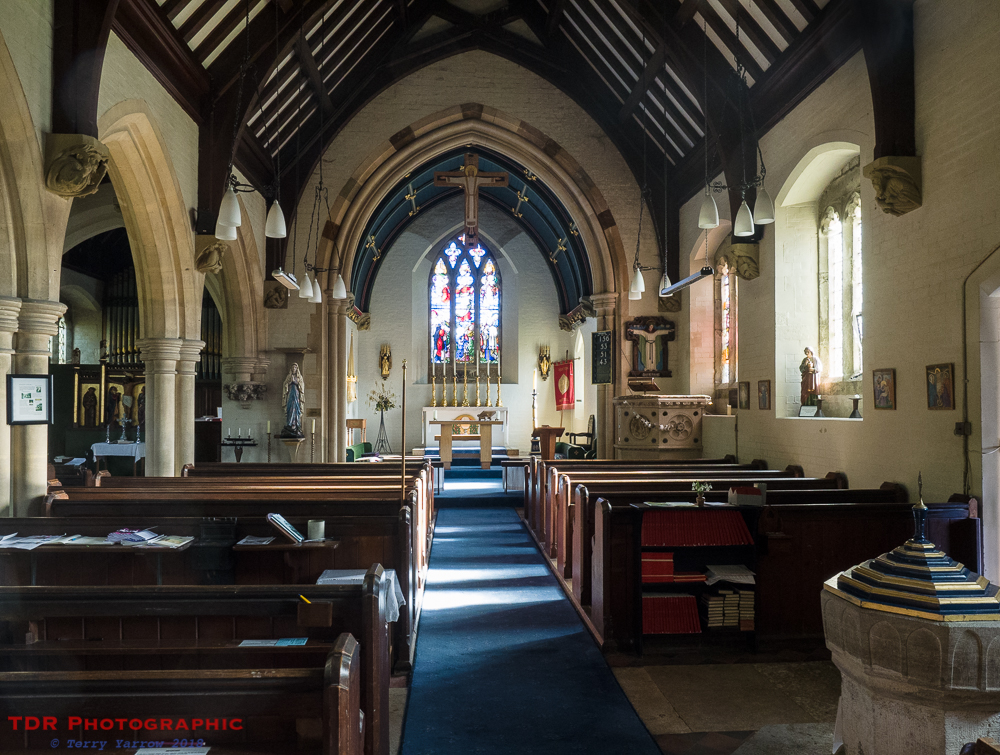
Leaving the village behind, I made my way cross country to climb the ridge that would take me to the next village, and the next church. The ridge is not high, only around 330 feet at its highest point, but because the surrounding land is flat, there are lovely views in all directions. In fact, so prominent is it that this was at one time the site of a semaphore signal used to pass information to London during the Napoleonic War.

It wasn’t long before I reached Chalbury itself, with its beautiful little church. All Saints, Chalbury, dates mainly from the 18th century although parts go back as far as the 12th century.

What sets this church apart, besides the fact that it is whitewashed, is its interior which comprises a complete set of 18th century box pews. These were very much hierarchical with the largest being reserved for the tenant of Chalbury Farm, followed by the next largest for the tenant of Didlington Farm, and then by the tenant of Uppington Farm. The Earl of Pembroke and his family occupied a splendid raised and canopied seat although how often they used it is not known. The Pembrokes lived at Wilton House some 20 miles away and their connection to the church came thanks to Henry VIII and the Dissolution of the Monasteries as St Mary’s Abbey in Wilton once owned Chalbury Church.

The church is small and has nothing particularly significant in terms of features but it is an absolute delight to visit, both for its position and its pretty interior. By now the sun had warmed and I sat on the seat outside to eat lunch gazing at the view from the churchyard. It really did feel like a spring day and I could have happily sat there for the afternoon!
All too soon though, it was time to move on and I continued along the ridge and down a country lane to reach the next mill on this walk.
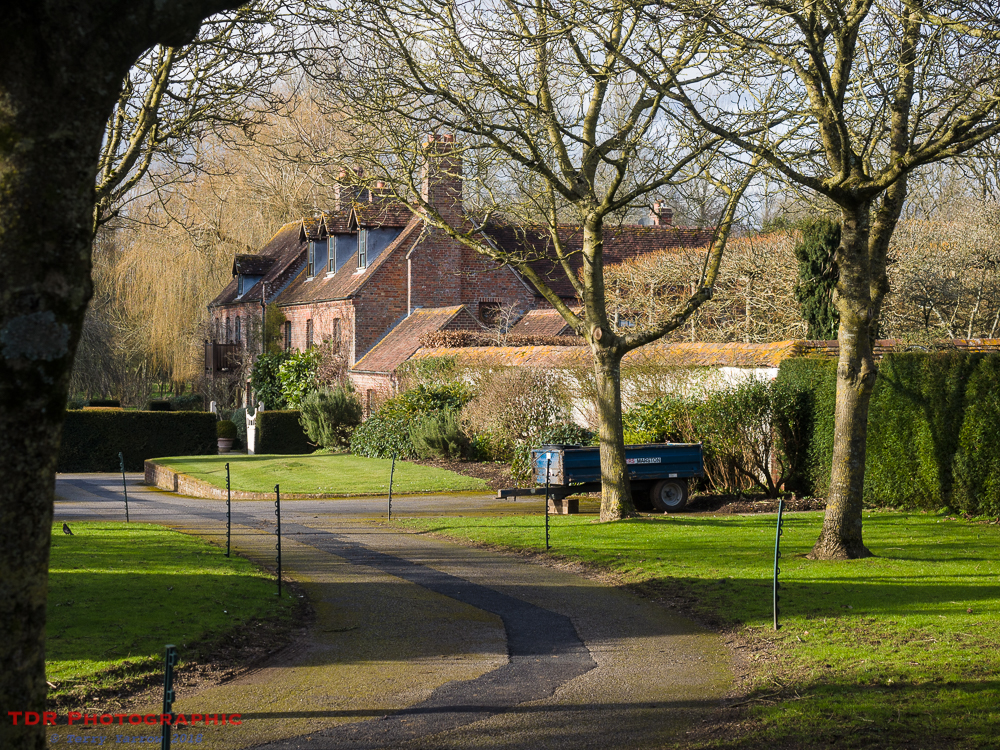
This is Stanbridge Mill, a one time flour mill on the banks of the River Allen. Now a private dwelling, it is not accessible to the public but one of the gardeners passed me and we fell into conversation. He told me that the mill and house is now owned by Lord and Lady Phillimore who took it over when the substantial Crichel Estate was broken up and sold in 2012. The mill is no longer working but the machinery is still intact and I understand that it still turns, although the water wheel apparently came off when last used. Sadly, only the house is visible from the footpath so I was not able to see the mill itself. However, they do take part in the Garden Open initiative so the next time that happens, it will be in my diary 🙂 !
Just downstream from the mill is the beautiful Stanbridge Bridge which crosses the River Allen. This fine bridge dates from medieval times although it was reconstructed in 1666 and widened nearly 100 years later.
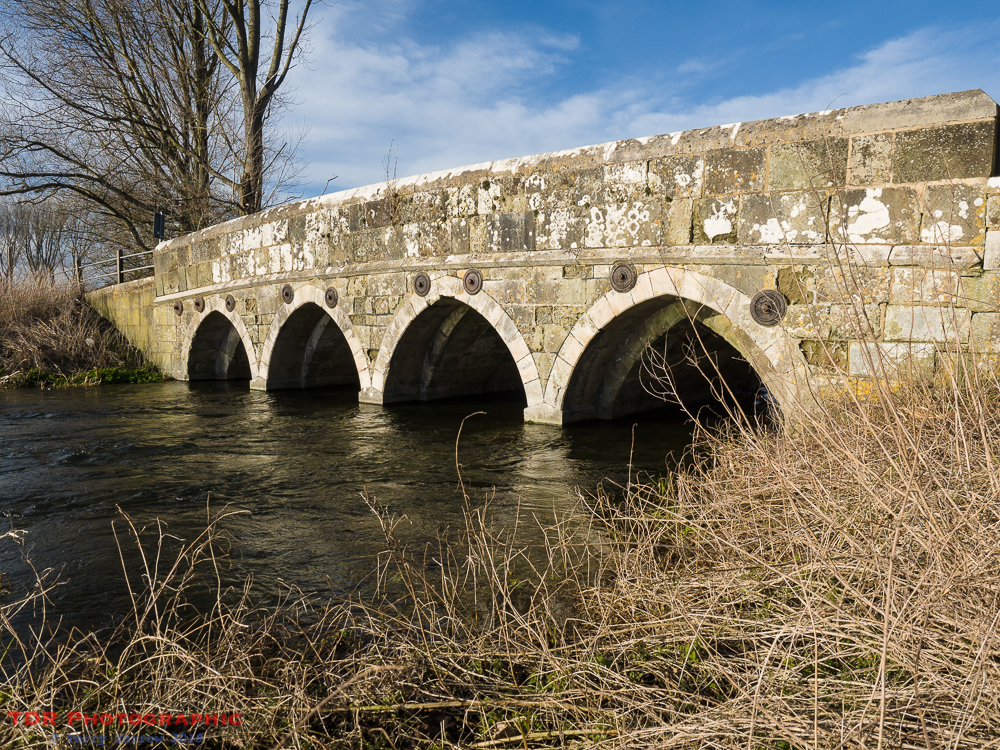
I made use of the bridge to cross the river and continued on my way towards the next mill, Crichel Mill. This well preserved corn mill still has the millstream flowing under it although, again, it is no longer used, being now part of a farm.

These mills seem to be very close along this stretch of what really is quite a small river, and very soon, I reached the next, Didington Mill. Or rather, I should say, what is left of it which isn’t much! It is actually on the right in the picture below – just part of the walls, some timber axels, and some ironwork, together with the pit which once held the water wheel. Again, this is now part of a private garden.
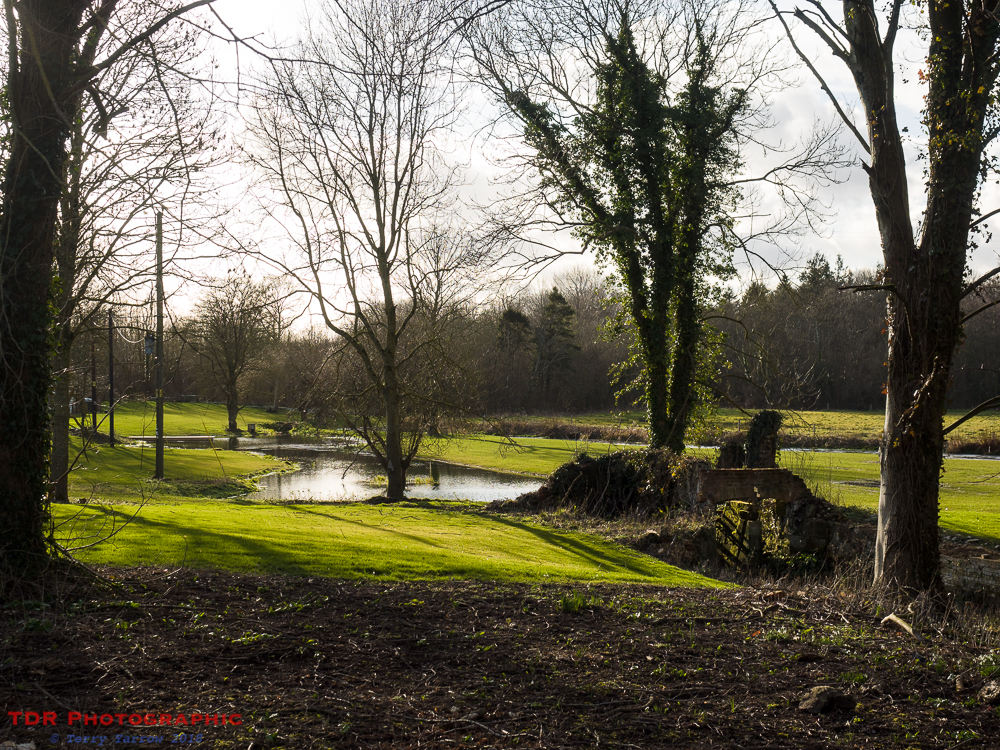
A lot of this land that I was walking, once belonged to the Crichel Estate, and the last section of my walk took me along one of the old carriageway routes that weave across the land and through the woods surrounding the huge kidney shaped lake that sits below the manor house. There are a number of ancient bridges that cross the River Allen as it winds serpentinely, criss crossing the path. Lichen, moss and ivy have carpeted much of the bridge sides.

The river here is particularly lovely, especially in the low evening sun that brings out the warm hues in the winter grasses. In the distance I could see a pair of swans taking an early evening swim and I waited for them to reach me so that I could include them as part of the scene. I waited in vain though as they decided to go downstream and eventually had to take the picture without them and move on.
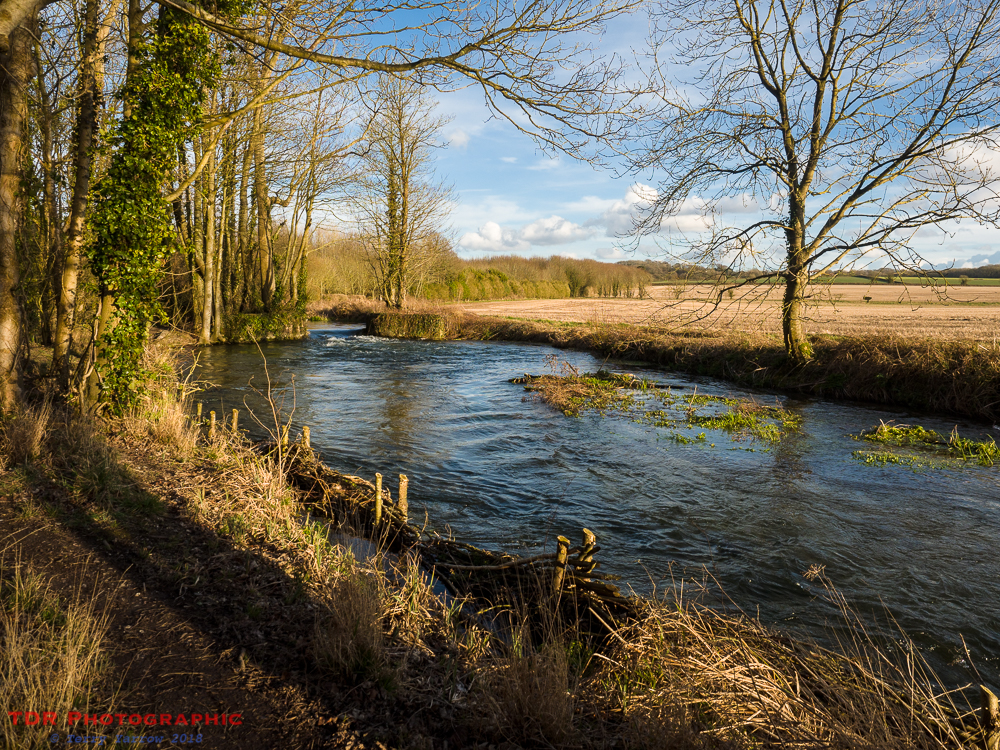
It seemed fitting to end this day with more snowdrops, and they were plentiful. The evening light was low and throwing warm tones across the woodland floor, highlighting the beauty of these favourite of flowers.

Finally, I reached the end of my walk but I couldn’t resist anther picture as the sun set through the trees.

What an amazing day this has been, four mills all in the space of not much more than 2 miles of river, two lovely churches, good views, wild flowers, singing birds, springlike sunshine – what could be better! I really hope you have enjoyed walking with me and that you will join me again on a future walk.
Thanks for stopping by.
Until next time,
Your friend
The Dorset Rambler
If you would like to contact me, my email address is terry.yarrow@gmail.com – comments and feedback are always welcomed.
All words and pictures in this blog are the copyright of The Dorset Rambler and may not be reproduced without permission.



Beautiful blog, loving following your walks.
Thanks Amanda, you are very kind.
Looks like a beautiful walk which I will try to emulate – you had much better weather than Bournemouth today!
Sadly not today Saran, I walked this route on Monday.
Beautiful photos. Thanks for taking us along on your walk. 🙂
Thank you for coming Lynette, its nice to have feedback and to know my posts are appreciated.
what a beautiful part of the world! enjoyed the walk… and yes, that fountain looks like one you can find in an Italian piazza.
Thanks papershots, great to have your feedback and to know you enjoyed my walk.
thank you for sharing it 🙂
Love this. I think my cousin lives in Hinton Martell so I will have to check the fountain out next time I go there!
Thanks Andy. It’s a lovely village.
Stunning photos.
Thanks Richard, you are very kind.
The box pews are quite special, I have only seen them once before, in north Devon I think. I agree with Treves about the fountain, it reminds me of one in Poole Park where it looks more in keeping.
There is one other local church that has a full set of box pews Philip. Whilst I like the fountain, it is a bit incongruous and I agree, it would work very well in Poole Park 🙂 !